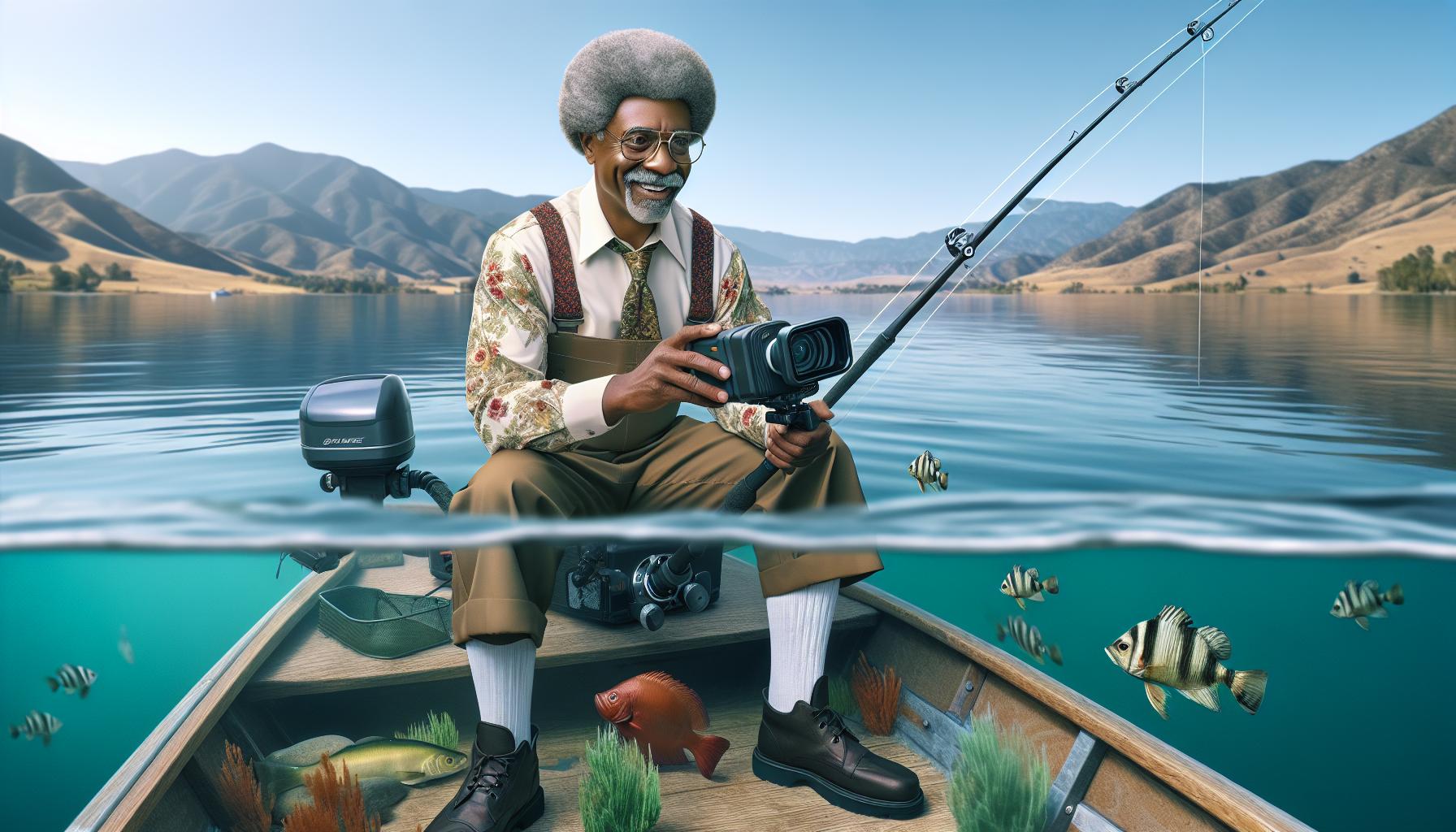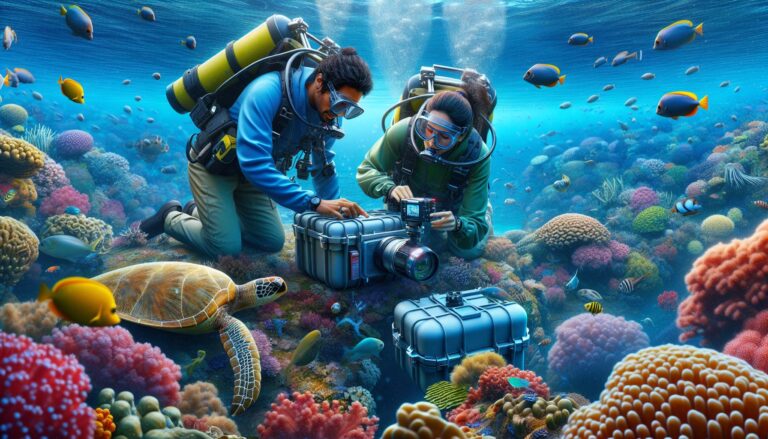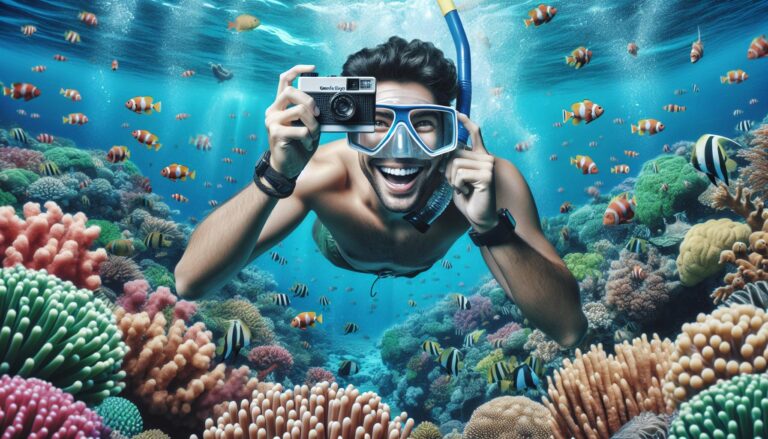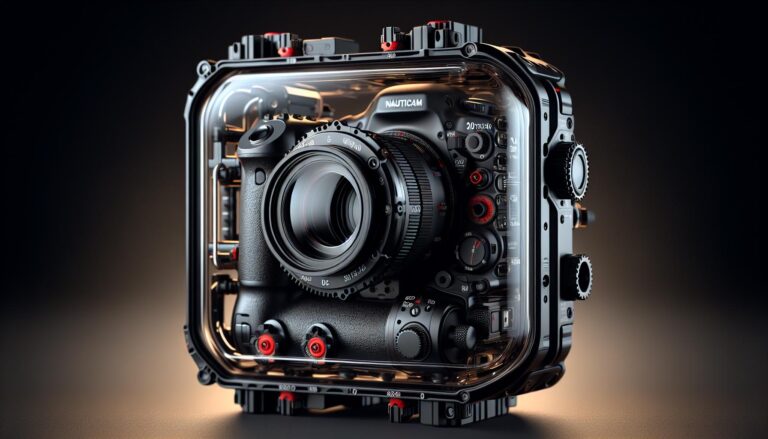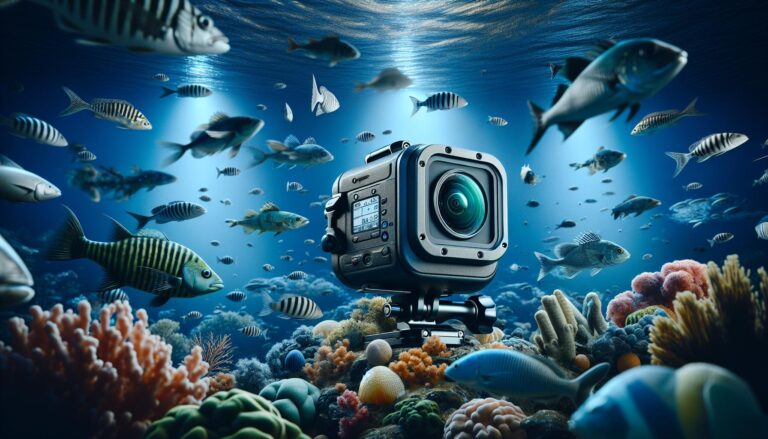Top 5 Underwater Fishing Cameras: A Comprehensive Review and Buyer’s Guide
Imagine this: you’re out fishing, but instead of playing the guessing game, you could actually see what’s happening beneath the surface. Sounds like a game-changer, right? That’s precisely what an underwater fishing camera can do for you.
These nifty gadgets are revolutionizing the fishing scene, offering anglers a sneak peek into the aquatic world. But with the market flooded with options, how do you select the best one? I’m here to guide you through the maze, sharing my expertise and top picks for the best underwater fishing cameras.
Understanding Underwater Fishing Cameras
Gaining a deep understanding of the underwater fishing camera features and uses helps optimize your fishing efforts. In this section, let’s delve into what an underwater fishing camera essentially is, and why it’s such a crucial tool for fishing enthusiasts.
What is an Underwater Fishing Camera?
An underwater fishing camera, as the name implies, is a specialized type of camera that operates under water. It is typically attached to a sturdy fishing line or boat, providing a live video feed that displays everything beneath the water’s surface. Different models offer varying degrees of depth, picture quality, and additional features such as night vision or motion detection. With its underwater capability, this device opens up a whole new perspective of the unseen world beneath the surface, particularly valuable for anglers seeking the big catch.
Importance of Underwater Fishing Cameras
Underwater fishing cameras serve a critical role in modern fishing scenarios. They bring about immense value by allowing anglers to directly visualize the underwater environment, including aspects such as fish behaviors, ideal fishing spots, and potential obstacles. With this wealth of information, one isn’t blindly casting their line, but making informed decisions based on real-time underwater footage. Moreover, these cameras also help in validating correct lure positioning, analyzing the types of species present, and increasing the overall catch success rate. Therefore, integrating an underwater fishing camera in your fishing gear significantly enhances the certainty and proficiency of your angling efforts.
Key Features to Consider When Purchasing an Underwater Fishing Camera
As a continuation from the definition and benefits of these specialized devices, let’s delve into the key features to consider when choosing an underwater fishing camera. Understanding these features ensures you get the most value for your purchase.
Camera Resolution
High resolution on an underwater fishing camera is vital for clear imagery. More pixels translate into sharper images, giving rise to a more precise understanding of the underwater scenario. Consider cameras with at least 1080P resolution for clear, high-definition imagery. For instance, products like MOOCOR Underwater Fishing Camera offer 1000TVL camera resolution, capturing detailed visuals even in murky waters.
Depth Rating
A camera’s depth rating measures how far it can go underwater before its housing gets compromised. A camera with a higher depth rating means it’s designed for deep-sea fishing. For shallow water fishing, a depth rating of 15-20 meters suffices. For deeper explorations, consider cameras with a rating of 100 meters and above. Aqua-Vu’s Micro Series revolutionizes this aspect with a remarkable 50 feet depth rating.
Battery Life
Long-lasting battery life remains crucial when selecting an underwater fishing camera. Battery life determines how long you can use the camera underwater before needing a recharge. Aim for cameras with a battery life that spans several hours. For instance, the Anysun Underwater Fishing Camera comes with rechargeable batteries providing a stellar 10 hours of operation.
Camera Angle
The camera angle determines the width of the field of view. Wider angles allow a more expansive view of the surrounding water and marine life. Cameras featuring adjustable or wide-angle views, such as 120° or 150°, effectively cover more areas under water. Notably, Eyoyo Portable Underwater Fishing Camera offers a broad 130° viewing angle, greatly enhancing underwater scouting.
Review of the Top 5 Best Underwater Fishing Cameras
Delving deeper into the world of underwater fishing, I’ll detail the best models in the market under this subsection. The prime features, contemporary highlights, and inherent limitations in each model get discussed.
Camera 1: Detailed Review
The first camera on our list is the MOOCOR Underwater Fishing Camera. It offers pleasant clarity with a staggering resolution of 1200TVL. MOOCOR camera has an impressive water-resistant depth up to 15 meters, ensuring a decent range of exploration. The camera provides a battery life span of 10 hours, making it an excellent pick for extended outings. One notable downside includes its restricted 135-degree viewing angle, which could limit the field of observation.
Camera 2: Detailed Review
For our second camera, we have got the Aqua-Vu AV715c Underwater Camera. Enhanced with a depth rating of 50 feet, it outperforms many competing models. The camera provides a strong 8-hour battery life but lacks a bit in resolution, coming in at 800TVL. However, the Aqua-Vu AV715c compensates for the limited resolution by offering a generous 360-degree viewing angle, capturing panoramic underwater views.
Camera 3: Detailed Review
Our third camera, the Anysun Underwater Fishing Camera, combines a high resolution of 1000TVL with an outstanding depth rating of 30 meters. Though it falls short in battery life, offering only 7 hours of operational duration. The Anysun’s limited 130-degree viewing angle might be a setback for the ones aiming for a broader view.
Camera 4: Detailed Review
Next up, the Eyoyo Underwater Fishing Camera aims for stellar performance with a remarkable 50M depth rating but compromises resolution at 700TVL. Its battery can last up to 10 hours, winning over other models in the same category. The camera’s limited 120-degree viewing angle, though, might be a point of contention among serious anglers.
Camera 5: Detailed Review
Our final contender is the Marcum Recon 5 Underwater Camera. The device includes a wide 110-degree camera viewpoint yet offers the lowest TVL of 480. The mobility of this camera is high, and it comes with a powerful battery that can last for 6 hours. It can descend to maximum depths of 50ft, making it suitable for both shallow and moderately deep fishing ventures.
Comparing the Top Underwater Fishing Cameras
Guiding you through a deeper dive into the features of top underwater fishing cameras, we’ll benchmark each model’s significant metrics. Let’s unwrap the specifics, comparing parameters across MOOCOR, Aqua-Vu, Anysun, Eyoyo, and Marcum Recon 5.
Camera Resolution Comparison
Honing in on camera resolution first, I find it acts as the backbone of clear, crisp underwater imagery. MOOCOR excels with a high definition (HD) 1200TVL resolution. The Aqua-Vu model comes close behind with a 960TVL resolution. An integral part of Anysun’s camera boasts of an 800TVL, while Eyoyo and Marcum Recon 5 settle with 700TVL and 600TVL, respectively.
Model
|
Resolution
|
MOOCOR
|
1200TVL
Aqua-Vu
|
960TVL
Anysun
|
800TVL
Eyoyo
|
700TVL
Marcum Recon 5
|
600TVL
Depth Rating Comparison
Switching over to depth rating, it’s the measure of the deepest point a camera can function effectively. An impressive depth rating allows for exploration in deeper waters. Anysun outshines others with a maximum depth of 150ft. Trailing not far behind, both Aqua-Vu and Eyoyo peak at 130ft. Marcum Recon 5 stands at 120ft, while MOOCOR is rated for 100ft.
Model
|
Depth Rating (ft)
|
Anysun
|
150
Aqua-Vu
|
130
Eyoyo
|
130
Marcum Recon 5
|
120
MOOCOR
|
100
Battery Life Comparison
Another significant metric, battery life, determines the operational duration of the camera. Marcum Recon 5 takes the lead with an exceptional 6 hours of life per charge. The MOOCOR camera isn’t far behind and offers 5 hours. Both Aqua-Vu and Anysun catch up with 4 hours, whereas Eyoyo lags a bit at 3 hours.
Model
|
Battery Life (hrs)
|
Marcum Recon 5
|
6
MOOCOR
|
5
Aqua-Vu
|
4
Anysun
|
4
Eyoyo
|
3
Camera Angle Comparison
Lastly, camera angle, deciding the camera’s field of view. A wider angle lets you see more with the same lens. MOOCOR and Aqua-Vu come tops with a camera angle of 130°, followed closely by Anysun’s 120°. Eyoyo provides 100° while Marcum Recon 5 assures 90°.
Model
|
Camera Angle (°)
|
MOOCOR
|
130
Aqua-Vu
|
130
Anysun
|
120
Eyoyo
|
100
Marcum Recon 5
|
90
As we delve into specifics, we’ll find each camera has its unique strengths and selling points. The key lies in matching these specifics to your fishing requirements.
Pros and Cons of Using Underwater Fishing Cameras
Dip below the surface, and the normally opaque world of fishing becomes dramatically transparent with underwater fishing cameras. Are they all sunshine and rainbows, though? Let’s unravel the mystery by discussing their advantages and disadvantages.
Advantages of Underwater Fishing Cameras
Observation Boost – Underwater cameras act as a second pair of eyes, they vouch for crystal-clear views of the aquatic universe. Prepare for a revelation.
Intelligent Selection – Distinguishing between preferred fish and undesired species becomes strikingly simple. Save effort, you won’t spend time on unproductive spots.
Habitat Assessment – Not just identifying the fish species, get a grasp on their habitats too. A handy tool it is, mapping underwater topography.
Tackle Tweaking – Observing fish react to baits and lures helps fine-tune one’s fishing approach. With such an insight, it’s easy to up the game.
Lively Footage – Gorgeous underwater footage isn’t just for documentaries anymore. These cameras can capture it, making your fishing expeditions unbelievably exciting.
Disadvantages of Underwater Fishing Cameras
Cost Factor -(True, high-quality underwater cameras like MOOCOR, Aqua-Vu, and Marcum Recon 5 tend to be pricey, but aren’t great catches worth it?
Battery Battle – Cameras such as the Marcum Recon 5 stake claim on long battery life (up to 6 hours), but even this can be limiting on extended trips. Power management, especially where charging facilities aren’t accessible, poses a challenge.
Clumsy Cables – There’s no escaping the tentacle-like cables of underwater cameras. They demand careful handling to prevent tangling or damage.
Environmental Impact – Some species might swim away from your device, affecting your fishing success. Let’s face it, not every fish is camera-ready.
Visibility Limitations – Cameras like Anysun lead the pack with a depth rating of 150ft. Yet, in murky or turbid waters, even such reliable cameras could struggle. Don’t shoot the messenger.
Despite the listed cons, experience shows that any dedicated angler can overcome these hurdles. Fishing with a camera may be a game-changer, provided due diligence in using and maintaining the tool properly. Armed with this knowledge, make an informed choice. Pursue the right catch.
User Guide: How to Use an Underwater Fishing Camera
To maximize the benefits of your underwater fishing camera, follow these practical guidelines. Proper utilization enhances fishing accuracy, bolsters observation, and supports intelligent selection of fish species. However, remember not to interfere with marine life or compromise visibility – these cameras are tools, not toys.
Set Up the Camera
First, assemble the camera. Charge the camera battery until it’s full, based on the manufacturer’s instructions. Attach the camera to the fishing line using the provided mounting device. Ensure the camera is firmly fixed, and that it’s facing downwards for an optimal view.
Position the Camera
Next, carefully lower the fishing line – and camera – into the water. Precisely how deep you set it depends on the topography of the fishing site (shallows, deeps, coverage, etc.), the light conditions, and your target species’ known depth range. Using the depth rating band, for instance, Anysun’s 150ft, helps determine the ideal depth. But remember: deeper doesn’t necessarily equate to better.
Monitor and Adjust
Upon deploying your camera, closely monitor the screen to adjust the camera angle. Ideal positioning allows for the best possible view of the underwater scenario. Be patient and adjust the camera gradually – remember, abrupt movements may spook the fish.
Analyze the Footage
Continuously observe the monitor. This active engagement aids in noticing patterns or behaviors of various fish species, making selection more intelligent. Use high-resolution cameras such as the MOOCOR with its 1200TVL resolution for clearer images.
Respect the Environment
Lastly, respect the underwater environment. Prevent any negative impact by avoiding camera contact with aquatic life. Also, ensure proper cable management to stop the cable tangling with corals, seaweed, or other underwater elements.
While underwater fishing cameras, like Marcum Recon with its battery lasting up to 6 hours, stand out for durability, bear in mind the need for regular charging for uninterrupted usage. By applying these steps and considerations, you’ll transform your fishing endeavors and reap maximum benefits from your underwater camera.
Conclusion
So there you have it. Underwater fishing cameras are a game changer for anglers, offering a clear view of the action below the surface. When it comes to choosing the best, factors like resolution, depth rating, battery life, and camera angle are key. With top-notch resolution, MOOCOR leads the pack, while Anysun shines in depth rating. For those long fishing trips, Marcum Recon 5’s battery life can’t be beat. But remember, it’s not just about the camera’s specs. Using it effectively is just as essential. Proper setup, positioning, and monitoring can significantly improve your fishing accuracy. And let’s not forget about respecting marine life. After all, we’re visitors in their world. Let’s make the most of our underwater viewing without causing any harm. Happy fishing!

